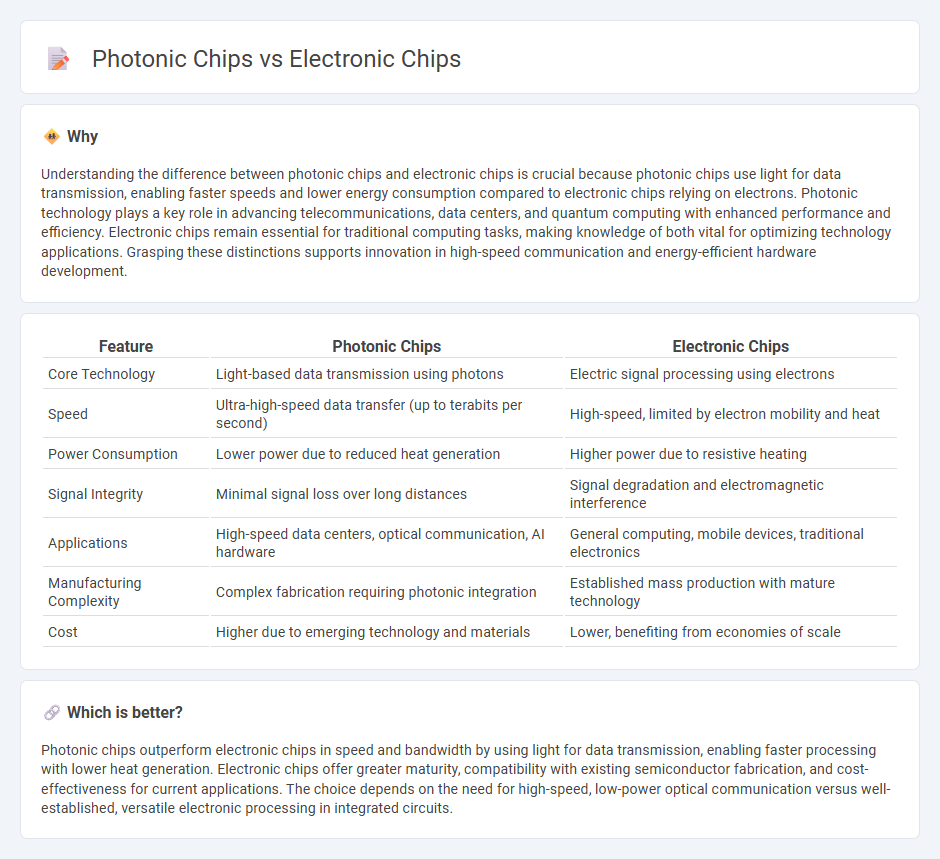
Photonic chips leverage light particles to transmit data at ultra-high speeds with minimal heat generation, outperforming traditional electronic chips that rely on electrons and face limitations due to electrical resistance and thermal buildup. The integration of photonic technology promises significant enhancements in bandwidth, energy efficiency, and processing power crucial for AI, data centers, and communication networks. Explore the advancements and potential applications of photonic chips compared to electronic chips to understand the future of computing technology.
Why it is important
Understanding the difference between photonic chips and electronic chips is crucial because photonic chips use light for data transmission, enabling faster speeds and lower energy consumption compared to electronic chips relying on electrons. Photonic technology plays a key role in advancing telecommunications, data centers, and quantum computing with enhanced performance and efficiency. Electronic chips remain essential for traditional computing tasks, making knowledge of both vital for optimizing technology applications. Grasping these distinctions supports innovation in high-speed communication and energy-efficient hardware development.
Comparison Table
| Feature | Photonic Chips | Electronic Chips |
|---|---|---|
| Core Technology | Light-based data transmission using photons | Electric signal processing using electrons |
| Speed | Ultra-high-speed data transfer (up to terabits per second) | High-speed, limited by electron mobility and heat |
| Power Consumption | Lower power due to reduced heat generation | Higher power due to resistive heating |
| Signal Integrity | Minimal signal loss over long distances | Signal degradation and electromagnetic interference |
| Applications | High-speed data centers, optical communication, AI hardware | General computing, mobile devices, traditional electronics |
| Manufacturing Complexity | Complex fabrication requiring photonic integration | Established mass production with mature technology |
| Cost | Higher due to emerging technology and materials | Lower, benefiting from economies of scale |
Which is better?
Photonic chips outperform electronic chips in speed and bandwidth by using light for data transmission, enabling faster processing with lower heat generation. Electronic chips offer greater maturity, compatibility with existing semiconductor fabrication, and cost-effectiveness for current applications. The choice depends on the need for high-speed, low-power optical communication versus well-established, versatile electronic processing in integrated circuits.
Connection
Photonic chips and electronic chips are connected through optoelectronic interfaces that convert electrical signals into optical signals and vice versa, enabling high-speed data transmission with minimal latency. These hybrid systems leverage the fast, low-loss communication capabilities of photonics alongside the processing power of electronics, optimizing performance in data centers and telecommunications. Integration techniques such as silicon photonics facilitate seamless interaction between the two chip types, enhancing energy efficiency and bandwidth.
Key Terms
Transistors
Electronic chips utilize transistors to control electrical signals, enabling computation through semiconductor-based amplification and switching. Photonic chips, by contrast, leverage light-based components such as optical transistors or modulators, offering higher speed and lower energy consumption by manipulating photons instead of electrons. Explore the latest advancements in transistor technology to understand the future trajectory of chip performance.
Waveguides
Waveguides in photonic chips enable the efficient transmission of light signals with minimal loss, surpassing traditional electronic chips' ability to carry electrical signals through copper interconnects, which face resistive heating and signal degradation at high frequencies. Photonic waveguides support bandwidths reaching terahertz frequencies, significantly enhancing data transfer rates and reducing latency in optical communication systems compared to electronic counterparts limited to gigahertz speeds. Explore the latest advancements in waveguide technology to understand how photonic chips are revolutionizing high-speed data processing and communications.
Integration density
Photonic chips offer higher integration density than traditional electronic chips by utilizing light signals to transmit data, enabling faster processing speeds and lower heat production. Advances in silicon photonics technology allow photonic circuits to be densely packed with thousands of optical components on a single chip, surpassing the limitations of electronic transistor miniaturization. Explore the latest developments to understand how photonic integration is reshaping computing performance and scalability.
Source and External Links
What is a Computer Chip? - AWS - A computer chip is a tiny wafer of semiconducting material with embedded electronic circuits, including analog, digital, mixed-signal, and quantum circuits that perform various computing functions by transmitting electrical signals through microscopic components.
Microchips: everything you need to know - IMEC - Microchips, or integrated circuits, are small pieces of semiconductor material containing complex electronic circuits with millions or billions of components like transistors that have revolutionized industry by enabling smaller, faster, and more efficient devices.
An Introduction to Microchips: Types & Manufacturing - Ansys - Microchips are semiconductor devices with different types of integrated circuits, such as analog, digital, and mixed-signal, designed to handle continuous or binary signals for a wide range of applications including smartphones, sensors, and processing units.
 dowidth.com
dowidth.com